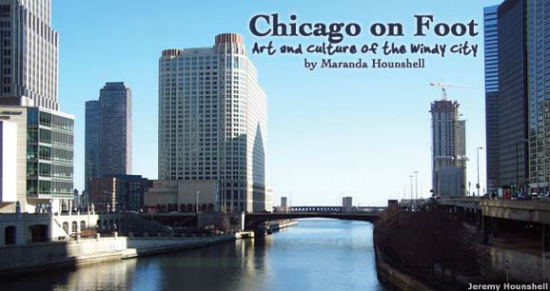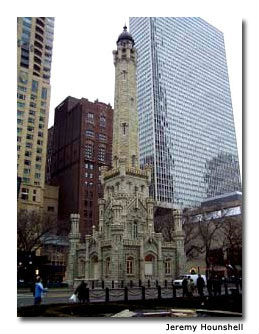

In the bustling northeastern Illinois metropolis of Chicago, just getting around can be half the adventure. With a public transportation system second in the United States only to New York, options include buses, taxis and the “L” train (Chicago’s elevated subway system, so nicknamed because when it was first completed in 1943, most of it was elevated). Of course there’s always the more scenic option of walking.
On a recent visit to the windy city, my husband, Jeremy, and I decided to forego the plethora of cabs and hoof it to most of our destinations as we explored the arts and the city’s rich architectural history. Touring Chicago on foot would give us the chance to explore corner cafes and bistros and make us feel a part of the city.
The Chicago Architecture Foundation (CAF) provides many options for viewing historic and modern-day architecture. In addition to bus, boat and neighborhood tours, guided walking tours are a great way to observe the city. Most of the tours last two hours, and begin at the ArchiCenter Shop & Tour Center in the Santa Fe Building, at 224 South Michigan Avenue.
The CAF tour guides are all volunteers, with a wealth of knowledge concerning not only the history of the buildings themselves, but also of the architects who designed them. Interesting asides about the city’s history keep tour-goers captivated along the journey.
Jeremy and I took the historic skyscrapers tour, which covers skyscrapers built between 1885 and 1935. We learned how Chicago’s architecture was forever changed by the Great Chicago Fire of 1871.
In 1870, Chicago was growing rapidly, with a population of 300,000 people, many of whom worked in manufacturing jobs. Then in 1871, a fire started in a barn outside Chicago, and strong winds spread it to the city.
More than 17,000 structures were destroyed, and several hundred people died in the fire. Since the United States was in a recession, rebuilding didn’t begin until a decade later.
With land at a premium by then, architects began expanding buildings vertically, instead of horizontally. The first skyscrapers built following the fire were 16 to 18 stories high.
During this time, a school of architects was active in Chicago, and they created what became known as the Chicago School of architecture, with innovations in structure and design that helped to make Chicago the birthplace of the skyscraper.
The new style included steel-frame buildings clad with terra cotta, numerous windows to bring in ambient light and simple exterior adornment. Architects who were instrumental in implementing this new style of design included Daniel Burnham and Louis Sullivan.
The Santa Fe Building (224 S. Michigan Ave.), designed by architect Daniel Burnham’s firm in 1904, is a prime example of the “Chicago School” style of architecture. It now houses the Chicago Architecture Foundation. This simple structure features clean lines and numerous windows.
The building was originally designed with a light well, which served the purpose of providing light to the inner spaces of the building. The light well was converted to an atrium in the 1980s.
The Old Colony Building (407 S. Dearborn St.), constructed in 1894 by William Holabird and partners, was also built in the Chicago School style. A unique design feature of this building is its rounded corners with oriel windows. Although the building has minimal ornamentation, the gracefully curved corners with windows add elegance to the exterior.
The Fine Arts Building (410 S. Michigan Ave.), built in 1885 by Solon S. Beman, is the oldest on the historic high-rises tour. Arched windows accentuate the top three floors. This building has the distinction of being the only one left in the city today with a human-operated elevator, which takes visitors back to a time when all elevators were run this way.
For those interested in modern architecture, a tour of skyscrapers built after 1950 is also available. This tour introduces visitors to architectural wonders such as the 1,450-foot-tall (442 m) Sears Tower (233 South Wacker Dr.), completed in 1974, which to this day remains the tallest building in North America, and the 1,127-foot-tall (344 m) John Hancock Center (875 North Michigan Ave.).
High atop the John Hancock Center, visitors can enjoy unobstructed views of the city from the open-air viewing center at the Hancock Observatory. The Chicago Architecture Foundation even offers a tour of the newly completed Millennium Park, a redeveloped section of Grant Park.
Millennium Park, which opened in the summer of 2004, is a showcase for art, including Cloud Gate, a 110-ton stainless-steel art structure. An outdoor pavilion here is the setting for free classical concerts on weekends. The 24.5 acre (0.10 km²) park also houses the amazing Crown Fountain, which consists of two 50-foot (15.2 m) glass blocks, and features lights and video images.
Chicago is also home to world-renowned art museums, such as the Field Museum, the Chicago Museum of Contemporary Art and the Art Institute of Chicago. The Field Museum is known for its blockbuster exhibits and its impressive research staff, especially in the fields of biology and paleontology.
The current exhibit, through January 1, 2007, is “Tutankhamun and the Golden Age of the Pharaohs.” Jeremy and I visited the Museum of Contemporary Art. The museum boasts an eclectic mix of works by well-known and new artists.

One work, called Proportioned to the Groove, 2005, by Sarah Sze, is composed of ordinary household items, including a bottle of glass cleaner and potato chip crumbs positioned on the floor, under a floor-to-ceiling canopy of string.
Visitors must navigate their way under a break in the string in order to continue to the next exhibit. Chuck Close’s Cindy, oil on canvas, is an example of pointillism. When I viewed up close, it appeared to be nothing more than a series of precisely placed dots, but when I stepped back 10 feet (3 m), it became a portrait of a woman.
We also explored The Art Institute of Chicago, which has two functions: a top-notch art school and a museum. In the institute’s Kraft Education Center, for young children, the long-term display “Faces, Places and Inner Spaces” combines paintings, sculpture and hands-on activities to help children develop their own stories.
Artists’ demonstrations, family activities and the Family Reading Room are other important parts of the institute’s mission to introduce children to art. The institute was recently named one of the 10 best art museums for kids by Child magazine.
Upstairs is a diverse art collection with objects ranging from African art, arms and armor to European decorative arts. Chinese, Japanese, Korean and Indian works of art are displayed here, with an extensive exhibit of Japanese woodblock prints dating back to the early 17th century.
The museum also features an impressive collection of American and European paintings and drawings by Degas, Renoir, Monet and Picasso, among others. A new wing of the museum is slated to open in 2009, increasing museum space by 33 percent. The new wing will be constructed of glass, steel and limestone, and will house the museum’s modern and contemporary art collection.
Walking tours take re-fueling. Since Chicago is known for its Chicago-style pizza, with its thick, stuffed crust, at lunchtime we looked for a place to experience this local food. We settled in at a table at Giordano’s (www.giordanos.com), a Chicago-based chain.
Several locations are scattered throughout the city.
At dinnertime, we enjoyed the fare at the Coco Pazzo Café (636 N. Saint Clair St.), an intimate neighborhood restaurant specializing in casual Italian cuisine. Hand-painted murals on the walls added to the cozy ambiance, where we enjoyed a dinner of rigatoni butera with homemade fennel sausage and peas, and grilled ahi tuna.
We had to try the restaurant’s signature dessert, tartufo, scooped balls of chocolate and vanilla gelato, with almonds and dark chocolate–dipped cherries. Just like Chicago, it was plain on the outside, with surprising delights inside.
If You Go
Maps of the city and of the “L” transit system are very helpful navigating tools. Most museums offer a free day; call ahead or visit Websites to find out when these are.
Chicago Convention and Tourism Bureau
Chicago Architecture Foundation
Walking-tour tickets can be purchased for as little as US$ 11.
224 S. Michigan Ave.
312-922-3432
The Field Museum
1400 S. Lakeshore Dr.
312-922-9410
Museum of Contemporary Art
220 E. Chicago Ave.
312-280-2660
The Art Institute of Chicago
111 S. Michigan Ave.
312-443-3600
- How to Get Around in Sydney: A Local’s Guide to Traveling Around Sydney - April 24, 2024
- The Low-Key Magic of Ghent, Belgium - April 22, 2024
- Discover the Hidden Charm of Extremadura in Spain - April 20, 2024
